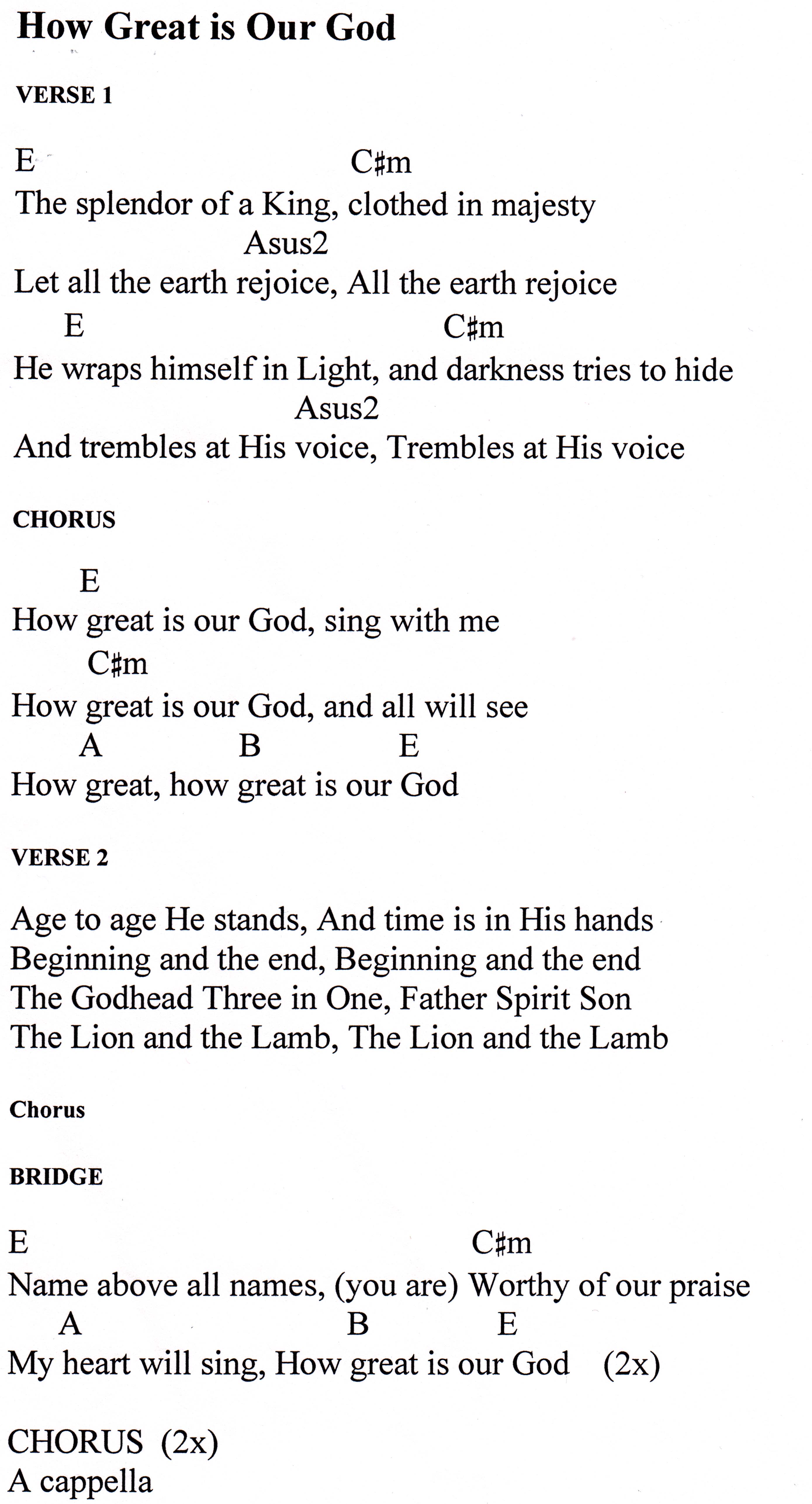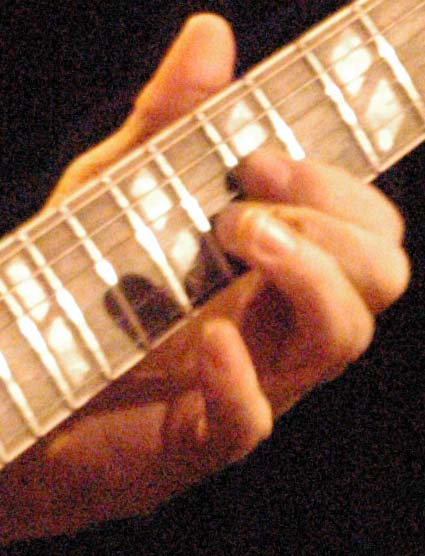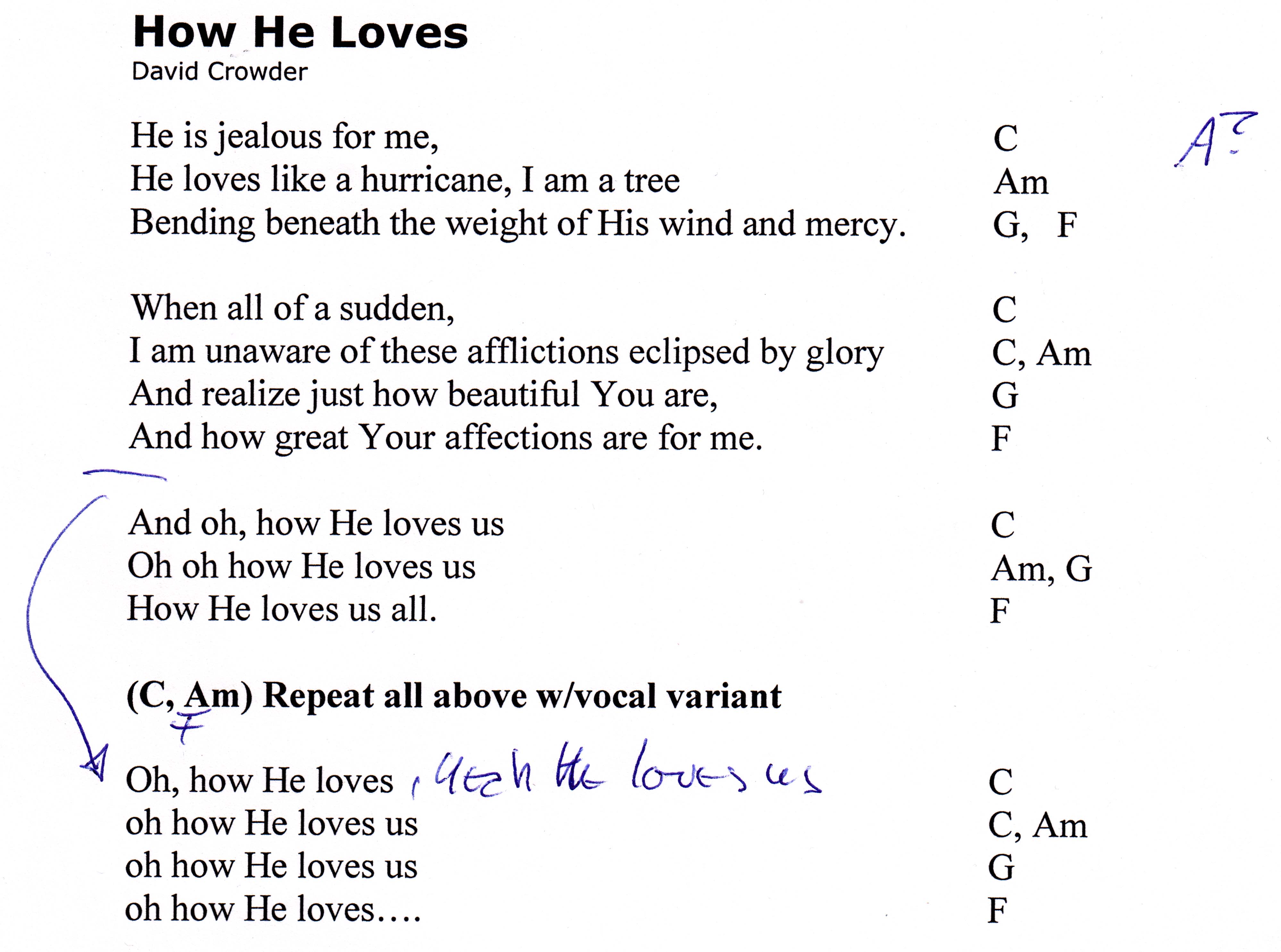

Hey, everybody!
One of the issues I get from people is on how to read charts, mainly those that have the chords sitting above the lyrics. How do you know when you're supposed to play
what, and for how long? How do you understand these?
For some of you, this may seem like a simple task. But many people just don't know, haven't been shown, and so are lost.
The simple fact of the matter is that with a lyric sheet that includes chords, there is no way to know anything if you haven't ever heard the song. It may as well be
a physics equation (unless you are a math wiz, in which case, make it something you don't know!).
Therefore, the best thing to do here is to not make any assumptions about these lyric sheets with chords, which look like this:

This is my own sheet of the song. I pulled it from a specific recording, lyrics and all. I know it's correct and true to the version I have on record - I
"vetted" it, meaning, I listened to the song, played along, learning the correct chords (not kinda sorta works chords), and the strum pattern.
The lyrics are right (listening multiple times to make sure) and the chords are correct, as mentioned above, and positioned above the word where the chord change takes
place (having written this out for someone else to sing).
You'll also notice that it is more a guide than including every detail. The First Verse and the Chorus are detailed once. The next verse, and subsequent
choruses are not detailed. The Second Verse is shown, but without chords. This is because the chord progression is identical to the First Verse
- so I need to memorize the progression. Same for the Chorus. I don't need to detail it again. I just look up at the first instance of the Chorus when I
need that part. The Bridge is "called out" because the chords are different and the lyrics are different.
If you are using the Internet to hunt down lyrics and chords, this can be problematic. There are dozens of lyric sites that give you this style of arrangement, to
have lyrics and chords together so you can play the song. But the likelihood the lyrics and chords are correct is probably around 60%. And I guarantee that in
many cases one or the other has errors. To be fair, most of these are "fan" sites. They are not governed by professional musicians, such as myself. Expect errors.
This next graphic is more typical of how I personally lay out a chart, showing only the first portion of the song. It has crib notes written in for direction. As much
as I can, I try to keep things on a single page, but it is not always possible.

I have yet to perform this song, so it is still a "work in progress", as you can see by the F being written under the C and Am chords between the Verse and first
Chorus. Notice the written direction to repeat everything above with vocal variation - so I don't have to write anything again, but will have to use my memory to
include the vocal changes. I also have an arrow pointing to where I go for the second chorus, after repeating the first verse.
Also, notice the chords are slammed all the way to the right. I don't need to have them over the lyrics. The comma represents measure separation. So each chord shown
plays out for 4 beats. I know the progression flow. As the main singer, I don't need that "help". If I made this for someone who was singing it, I might revert to the
typical chart, as with the example of "How Great", to help them know the vocal/chord cues for changes.
If you have read previous columns on transposing, you can start by putting your chart in the "right" key to learn it (the key as written/recorded). Then you can
change it to whatever key suits your voice, or the voice of whoever is singing the song. Notice the hand written A? on the upper right side? I'm trying
different keys to determine what best suits my voice. (A isn't working for me, so maybe G will be right...)
Okay, you've chosen your song, and have a chart with lyrics and chords. How do you figure out how to play it reasonably correct? Well, as mentioned, you'll need a
recording of the song. It doesn't have to be in the key of your chart. Just pick the version you want to emulate, to copy. Right now, you need to place the
chords where they belong, based on when they occur. What I mean is simply this: listen to the song, follow along with the lyrics. When the chord
changes, what word is it changing over (just before, or just after)? That's when you make the change. Your copy of the chart may be correct in chord placement, so you
will simply be verifying the position of the chords as correct, if that is the case - always a wise thing to do.
Next, you want to count out the beats so you know how long to play the chord, how many measures (usually four beats per measure) to play
the given chord. You can write a little crib note next to the chord, like this: C (4b). The "(4b)" is four beats. You can literally create your own little
"shorthand" way to make notes, but may have to explain it to whomever you give a copy of the chart. Keep it simple and easy for anyone to understand! I write out
charts for whole bands. They have to understand the shorthand, so I keep it easy and obvious as I can.
Bear in mind, sometimes there is more than one chord in a measure, so knowing how to count is really critical to playing the changes correctly. It isn't hard, just a
little more work if you are new to this. Be patient with yourself. You'll get it with repeated listens and then in learning to play the song.
As you begin to play through the song, you'll start to feel the changes, when they occur. I know this sounds kind of stupid, but it's true. Songs
telegraph when changes are going to happen; they let you know in advance. It just involves learning how to listen for it.
Once you understand the flow, the changes, and the strum patterns, and have a decent handle on playing through the song, you can begin to think about the other parts
of the equation. Is the original key good for whoever is going to be singing? Yes/no? Sit down with the singer and figure it out. Find their sweet spot - play the
whole song, not just a verse and chorus. Songs are dynamic and often have variations in them; allow the singer to stretch out to see if the given key is going to
work all the way through the song. When you find the right key, then rewrite the chords, put it in a word processor and make it clean.
I am occasionally called upon to play the drum kit in Worship. I always request copies of the lyric sheets. Why? Because I'm going to write notes to myself about what
to play, where breaks happen, lead in fills, where I lay out and do not play, and other stuff so I don't have to cram it all in my memory. And I use vocal cues for
most changes. The chart becomes my brain! And, if called upon to play a given song again, I have the chart all plotted out. I don't have to do anything except review
the tune before rehearsal; and during rehearsal, following the chart will do the rest!
Good charts, with relevant notes, are invaluable. When done right, you almost don't have to remember anything at all. I'm being a bit dramatic here, but the point is
very simple: if you know the song, have played it enough times, it is possible, even laying off the song for six months, to come back to the song and look at the
chart you made, with good notes, and remember everything within a couple minutes.
Hopefully, I've given you enough information here to help you understand the important elements in learning how to read a chart, how to create a good chart, and
that you will be able to emulate this time and again to good effect and with beneficial results for your Worship team.
Until next time, keep making a joyous noise for the Lord.